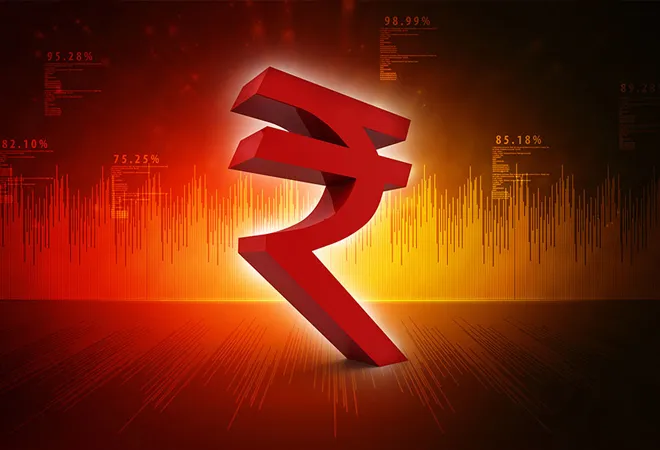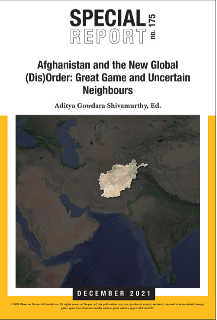
One unanticipated outcome of the unending Ukraine conflict is that the unilateral US-led Western sanctions on Russia have forced nations like India and China to move away from trading in American dollars—the world’s ‘reserve currency’—as they could not afford to miss out on the ‘cheap oil’ that Moscow offered. It also set off an Indian effort to try and make the rupee an ‘international currency’ on a par with the dollar and the rest.
This is not the first time that the Indian rupee is going global. In the ’60s, nations like Malaysia, Kuwait, Bahrain, Qatar, and the United Arab Emirates (UAE) all used the Indian currency, calling it the ‘Gulf rupee’. Over time, they replaced it with their own independent currencies.
Even before the Ukraine crisis, neighbouring nations like Maldives, Sri Lanka, and occasionally, Bangladesh, all sought facilities to either trade in the Indian rupee or for floating a common ‘South Asian currency’.
Even today, through bilateral agreements, the Indian rupee is an accepted currency in neighbouring Nepal and Bhutan, but these nations cannot use it for trading with a third nation. It is used and accepted unofficially in other neighbouring nations, too.
South Asian currency
Even before the Ukraine crisis, neighbouring nations like Maldives, Sri Lanka, and occasionally, Bangladesh, all sought facilities to either trade in the Indian rupee or for floating a common ‘South Asian currency’. Former Presidents Mohammed Nasheed (Maldives) and Mahinda Rajapaksa (Sri Lanka) were
keen advocates of the idea and had flagged the possibility in SAARC summits and bilateral talks with Indian leadership. However, they did not receive a positive response.
In between, Sri Lanka and Maldives also wanted to pay for Iranian oil with the Indian rupee after
New Delhi worked out modalities for paying Tehran, following Washington’s sanctions. Against this background, how India’s neighbours follow up on their own earlier proposals, that India has since met partially through rupee-trade, without mentioning a common currency, will determine the future course.
Losing at both ends
After India announced its decision to make the rupee go global, neighbouring countries like Sri Lanka, Bangladesh, and Myanmar grabbed the opportunity. Rather, they expressed a ready desire to handle their bilateral and possible third-nation trade in the Indian currency. Of course, with
Russia, India explored the possibility first. According to reports,
as many as 35 nations, including other oil-selling nations like Saudi Arabia, have expressed an interest, at least at the bilateral level.
Malyasia is the most recent country to facilitate bilateral trade in Indian rupees.
After India announced its decision to make the rupee go global, neighbouring countries like Sri Lanka, Bangladesh, and Myanmar grabbed the opportunity.
Trading in the Indian rupee has its advantages for both India and its trading partners. To begin with, whether it is trade or travel, individuals, businesses and governments lose on dollar exchange-rate at both ends, as they need to first buy dollars in their country and later convert at least a part of it to the local currency in their destination country. According to Sri Lankan banking experts, businessmen in the two countries
will save 50 percent in transaction costs while trading in the Indian rupee instead of routing payments through a clearing bank in the United States (US).
In a meeting with India’s Reserve Bank of India (RBI) Governor Shaktikanta Das in Mumbai, Sri Lankan
High Commissioner Milinda Moragoda has since discussed undertaking bilateral trade in the Indian rupee. Meanwhile, in a joint presentation to the nation’s commercial creditors in Colombo, Sri Lanka’s Central Bank Governor Nandalal Weerasinghe and Treasury Secretary Mahinda Siriwardana went one step further and
‘signalled willingness to consider rupee-debt for restructuring’.
Cautious optimism
For trading in Indian currency, nations, including India, have to permit banks to open ‘
Special Vostro accounts’ only through which such transactions could be managed. Given that massive dollar-shortage was both a cause and effect of Sri Lanka’s continuing economic chill, the nation was eager to grab whatever alternate option was available.
India’s neighbours like Bangladesh, Myanmar, and Nepal, too, constantly face a dollar-shortage. The same would have applied to Pakistan as well if bilateral relations were normal.
Given that massive dollar-shortage was both a cause and effect of Sri Lanka’s continuing economic chill, the nation was eager to grab whatever alternate option was available.
However, there is a need for cautious optimism on the Indian side. In the previous century, the country engaged in rupee-rouble trade but, later on, Moscow evinced less interest as they did not have much to purchase from India in return for the high-value imports by India. News reports now suggest that
Russian oil is being traded not for the Indian rupee, but in American dollars.
Global trade
After Chinese President Xi Jinping’s recent meeting with Russian counterpart Vladimir Putin in Moscow, where the focus mainly was on Beijing’s 12-Point Peace Proposal to end the Ukraine War,
Russia has reportedly embraced the yuan as an alternative to the banned dollar for international trade.
Saudi Arabia too is said to be considering trading its oil in yuan instead of the dollar.
Prima facie, for India, it is saying a lot in terms of bilateral, trilateral and multilateral geopolitics and geoeconomics. However, the contours need to be known before coming to conclusions. Despite the wide acceptance of the idea of the Indian rupee being used as a global currency,
it accounts for only 1.6 percent of the daily average global trade. The figure was 0.7 percent in 2007. The rupee has made some progress but not enough to stand on its own legs or for other nations to bet on it. The rupee thus compares unfavourably with the US dollar (88 pc), euro (31 pc), yen (17 pc) and pound-sterling (13 pc) as a share in daily average global trade.
Also, the Reserve Bank of India (RBI), despite promoting rupee-based trade, is still
reluctant to allow full convertibility, fearing capital flight and unpredictable exchange shocks. In context, bilateral and international players will be looking for signals from the RBI in the matter. It is a chicken-and-egg situation just now, and even neighbours, under the evolving situation, may want to wait-and-watch for a while.
Win-win situation
Yet, there is an urgent need not to politicise the win-win process domestically in India. For instance, on social media, some Sri Lankan economists have cautioned against putting all the nation’s trading and earning eggs in one basket, namely, the Indian rupee. They argue that the increasing dependence on trade based on the Indian rupee might create a balance-of-payments situation, where the country might end up having to source all its supplies, comprising food, medicines and industrial goods, from India (or any other nation in its place).
However, the contours need to be known before coming to conclusions. Despite the wide acceptance of the idea of the Indian rupee being used as a global currency, it accounts for only 1.6 percent of the daily average global trade.
This could lead to a situation where the nation would still be left without enough dollars, which is still the global reserve, and which the nation will need in abundance to pay for imports from other nations and to pay back the existing debt and interest. They visualise such a scenario at least in the medium term. What is true of Sri Lanka is true of other neighbours, too.
Slow but sure steps
For months since the Sri Lankan rupee and economy have relatively stabilised, the government has been urging businesses and individuals to repatriate back home the dollars that they have been parking overseas, either in banks or with business partners, owing to the volatility of the Sri Lankan rupee and also the direction for local banks not to permit dollar-purchase or expatriation. This has led to a situation in which Sri Lankan businesses, while welcoming rupee-trade, are yet to take the big step forward.
All of it means that for the Indian rupee to be accepted as an international currency, it would have to travel a longer distance through unchartered territory. Such a course is true also for its trading partners. The rupee will end their dependence on the dollar, euro, and pound-sterling, yes, but for that to happen nations will have to study bilateral trade and possibilities with India. India should also undertake similar studies, and at the same time create such mechanisms as may be required to understand the dynamics of the transition, and take slow but sure steps towards it.
The views expressed above belong to the author(s). ORF research and analyses now available on Telegram! Click here to access our curated content — blogs, longforms and interviews.



 One unanticipated outcome of the unending Ukraine conflict is that the unilateral US-led Western sanctions on Russia have forced nations like India and China to move away from trading in American dollars—the world’s ‘reserve currency’—as they could not afford to miss out on the ‘cheap oil’ that Moscow offered. It also set off an Indian effort to try and make the rupee an ‘international currency’ on a par with the dollar and the rest.
One unanticipated outcome of the unending Ukraine conflict is that the unilateral US-led Western sanctions on Russia have forced nations like India and China to move away from trading in American dollars—the world’s ‘reserve currency’—as they could not afford to miss out on the ‘cheap oil’ that Moscow offered. It also set off an Indian effort to try and make the rupee an ‘international currency’ on a par with the dollar and the rest.
 PREV
PREV


